Libraries of all kinds have suffered damages and loss due to environmental disasters like earthquakes, hurricanes, and floods. As hurricane season comes to a close (officially June 1 to November 30), it’s a good time to reflect on disaster planning. Hurricanes Florence and Michael caused significant damage in the United States this year, and Puerto Rico is still rebuilding following last year’s Hurricane Maria.
The ALA Archives holds many photographs and records documenting past disasters. Here is a look at a few of them. If these photos scare you, be sure to check out ALA’s Disaster Preparedness and Recovery resources to make sure your library is ready with a disaster plan. We hope you won’t need it!
Puget Sound Earthquake, 1949
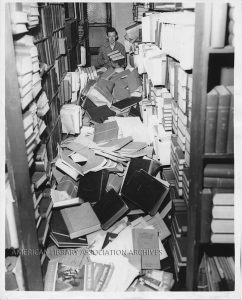
On April 13, 1949 the Puget Sound area of Washington state felt a 7.1 magnitude earthquake, one of the worst ever recorded in that area [1]. Eight people were killed, many were injured, and Seattle, Tacoma, Olympia, and surrounding towns reported significant damage to buildings. It was reported that 1,900 brick walls in Seattle collapsed, fractured, or bulged. In this photo, a librarian at the Seattle Public Library begins picking up books that were toppled off the shelves by the quake. This photo appeared on the cover of the May 1949 ALA Bulletin with the description, “most of the libraries in the Pacific Northwest area, shaken by an earthquake on April 13, reported only superficial damage to the buildings.”
Colorado State University Flood, 1951
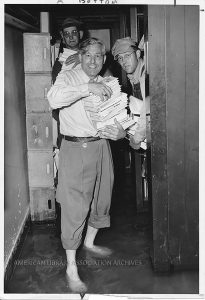
In 1951, Colorado State University (then known as Colorado A&M College) experienced flooding from Spring Creek. Floods in 1938 and 1997 caused similar damage. The 1997 flood caused significant damage to Morgan Library and other campus buildings, as well as significant damage to library books, including mold damage. A 10-year reflection on the 1997 flood reports that the campus now has much improved emergency management, flood-deterrent landscaping, and a nationally renowned mold mitigation lab [2]. The original caption of this photo reads: “Director James G. Hodgson, of Colorado A&M College Library, shows some of the campus crew where to take the books and printed matter that had to be moved during a flood.”
Loma Prieta Earthquake, San Francisco, 1989
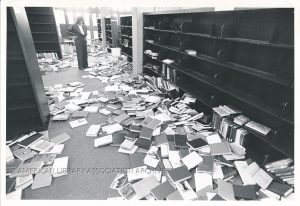
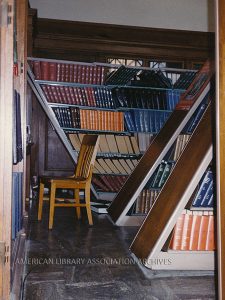
On October 17, 1989, a 7.1-magnatude earthquake struck the San Francisco area. Known as the Loma Prieta Earthquake, it killed over 60 people and caused more than $10 billion in damage [3]. However, American Libraries reported one month later that damage to libraries in the area was not as severe as initially thought, and no deaths or injuries to library staff or patrons were reported [4]. Most libraries avoided structural damage, and sustained mostly cosmetic damage to their buildings. Metal shelving proved to be a wide-spread issue, with multiple institutions experiencing collapsed, fallen, or bent and twisted metal shelving, which left millions of books spilled onto the floor. The ALA organized a disaster relief fund for libraries effected.
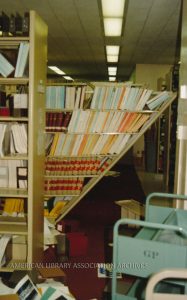
At the time, San Francisco Public Library Director Ken Dowlin told American Libraries that the extensive renovations and inventory needed after the quake could be an opportunity to begin creating an online catalog for SFPL [4]. SFPL had shattered glass and marble floors, and non-structural damage to walls, which left many areas inaccessible. San Francisco State University Library had damage which allowed asbestos to escape on the sixth floor, rendering special collections areas on the seventh floor (the top floor of the building) inaccessible. Stanford University’s libraries faced the most structural damage of the libraries pictured here because of their older buildings. Thankfully Stanford had recently had significant renovations to seismically brace the seven-level book stacks in Green Library, the campus’ main library, which significantly reduced damage and injury.
Hurricane Georges, Mississippi, 1998
In this photo from the aftermath of Hurricane Georges in 1998, Head of Reference Service Manager John Batson (right) and Reference Assistant Stuart Walker remove protective plastic sheeting from an online terminal at the Jackson-George Regional Headquarters Library in Pascagoula, Mississippi. Hurricane Georges caused an estimated $2.9 billion dollars in damage across Florida, Alabama, Mississippi, and Louisiana. Georges reached Category 4 intensity, and made landfall on the Mississippi coast on September 28th, where it quickly weakened into a tropical depression [5].

References
- “Earthquake Hits Puget Sound Area on April 13, 1949.” Accessed November 27, 2018. http://www.historylink.org/File/2063.
- “Rising Above: Colorado State University 10 Years After the Spring Creek Flood | Public Relations | Colorado State University.” Accessed November 27, 2018. https://publicrelations.colostate.edu/2007/07/26/rising-above-colorado-state-university-10-years-after-the-spring-creek-flood/.
- “M 6.9 October 17, 1989 Loma Prieta Earthquake.” Accessed November 27, 2018. https://earthquake.usgs.gov/earthquakes/events/1989lomaprieta/.
- Flagg, Gordon. “News Fronts: Libraries Dig Out from Bay Area Earthquake.” American Libraries 20, no. 11 (1989): 1022-038.
- US Department of Commerce, NOAA. “Hurricane Georges – September 1998.” Accessed November 27, 2018. https://www.weather.gov/mob/georges.